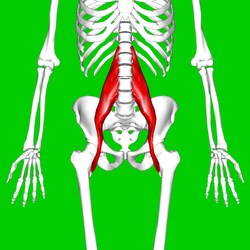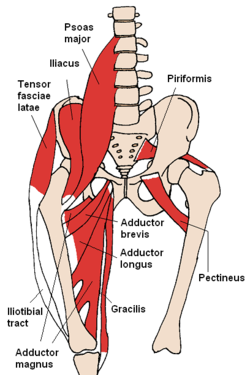| Psoas major muscle | |
|---|---|
 Position of psoas major (shown in red) | |
 The psoas major and nearby muscles | |
| Details | |
| Origin | Transverse processes of T12–L4 and the lateral aspects of the discs between them |
| Insertion | In the lesser trochanter of the femur |
| Artery | lumbar branch of iliolumbar artery |
| Nerve | Lumbar plexus via anterior branches of L1–L3 nerves |
| Actions | Flexion in the hip joint |
| Antagonist | Gluteus maximus |
| Identifiers | |
| Latin | musculus psoas major |
| TA98 | A04.7.02.004 |
| TA2 | 2595 |
| FMA | 18060 |
| Anatomical terms of muscle | |
The psoas major (/ˈsoʊ.əs/ or /ˈsoʊ.æs/; from Ancient Greek: ψόᾱ, romanized: psóā, lit. 'muscles of the loins') is a long fusiform muscle located in the lateral lumbar region between the vertebral column and the brim of the lesser pelvis. It joins the iliacus muscle to form the iliopsoas. In animals, this muscle is equivalent to the tenderloin.